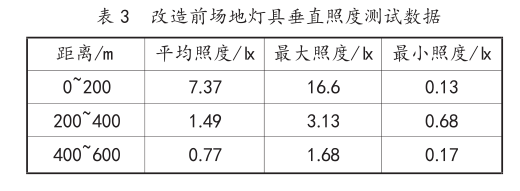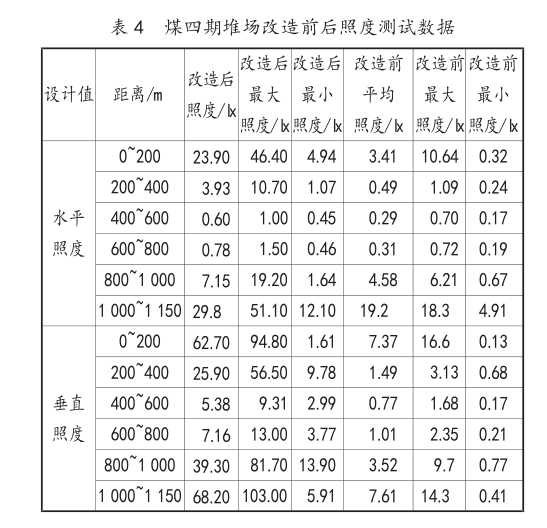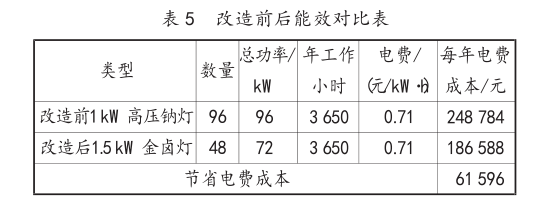Lighting technology modification of high pole lights in coal terminal yards
Abstract: To optimize the coal terminal yard high pole lights Illumination illumination, through the horizontal and vertical lighting test, measuring the illumination of each position of the yard, replacing 1000 W high-pressure sodium lamp with a small amount of high-performance 1500 W metal halide lamp, and simultaneously repairing the lifting mechanism for improving the high pole lamp The lamp panel mechanism effectively improves the illumination and uniformity of the yard illumination and the reliability of the high pole lamp, reduces the maintenance difficulty of the high pole lamp, and effectively reduces the total power of the illumination to achieve the purpose of energy saving and consumption reduction.
Keywords: port; coal terminal; yard; high pole light
1 background
Qinhuangdao Port Coal Phase IV project is a dedicated coal export terminal, mainly Relying on the Daqin Railway, the coal from Shanxi and Inner Mongolia will be transported to East China and South China. There are 12 high pole lights in the fourth phase of the coal yard, of which there are 6 high pole lights. The high pole lamp mainly supports the site lighting. Because the existing lighting facilities have been used for a long time, most of them can not be used normally, which causes the night illumination illumination in the working area to meet the minimum requirements of the national standard. There is a safety hazard, and it is urgent to transform and improve the illumination. To meet the actual needs of safe production.
2 Status of yard lighting before renovation
2.1 Situation of yard lighting equipment
The length of the fourth stage of coal is 1150 m, with a total of 12 m poles of 40 m Install 8 sets of 1000W high-pressure sodium lamps on each pole. The venue is used for 24h. The average lighting of the lamps is 10~11h per day. The existing light pole control system performs remote control room control through a unified switch.
2.1.1 Problems existing in the equipment before the transformation After the field survey, the 12 stages of the 40 m high-beam equipment in the fourth stage of the coal transformation were manually lowered, and the following problems existed:
1 The top end of the rod body and the lamp panel have no hook unloading system, and the wire rope is subjected to long-term stress, and there is a risk that the wire rope is broken and the lamp panel falls.
2) With an external manual lifting device, the operator needs to operate under the lamp panel. If an accident occurs, it is easy to cause personal injury.
3) The lamp panel adopts no hook design. The wire rope has been subjected to long-term stress, and the phenomenon of “jumping” has appeared. It is easy to cause the wire rope to break and cause the lamp to fall.
4) The lifting mechanism is seriously aging, and most of them are not working properly, and the lamps cannot be repaired.
2.2 Before the renovation, the yard lighting test test selected two 40 m high poles (hereinafter referred to as "LT1" and "LT2" poles) between the sixth phase of the coal yard and the yard seven. The light poles LT1 and LT2 are located at the two ends of the site, with a coal yard and an intermediate road in the middle. The total length of the road is 1150 m, as shown in Figure 1. The horizontal distance between the yard and the pole is 7 m, which is the main test target area. The test is divided into a horizontal illumination test and a vertical illumination test. The test uses the grid method. According to the site conditions, the grid points have a lateral spacing of 5 m and a longitudinal spacing of 10 m.

2.2.1 Before the renovation The horizontal illuminance test data of the luminaire before the modification of the horizontal illuminance test data is shown in Table 2.

0~200 m Horizontal illumination: The maximum illumination value is 10.64 lx within 30 m from the pole, but it is worth noting that only 2 test points exceed 10 lx for the entire test range. The average illuminance of the area is only 3.41 lx. This region rapidly increases from 0.55 lx at the 0 m position to more than 10 lx at the 20 m position, and then rapidly decreases, causing local flare problems. The illuminance has been reduced to 1~2 lx at the critical point of 100 m from the pole, and the illumination attenuation is obvious. When it reaches 170 m, it has been reduced to below 1 lx, and the minimum has dropped to 0.32 lx. 200~400 m Horizontal illumination: The illumination in this area is basically below 1 lx, the average illumination is only 0.49 lx, and the minimum has dropped to 0.24 lx. From the perspective of human visual sense and the need for practical use of the road, this area is already in a relatively dark area and requires auxiliary lighting.
400~600 m Horizontal illumination: The test illumination of most test points in this area is below 0.5 lx, and the lowest value is in the middle of the entire 1150 m road, only 0.17 lx. Auxiliary lighting is also required for road work in this area.
2.2.2 The vertical illuminance data of the luminaires before the retrofit of the luminaires before the retrofit is shown in Table 3.

0~200m Vertical illumination: gradually increased from the lowest position of the pole, with an average of 7.37lx and a maximum of 16.6lx. The illuminance is reduced to 2~3lx at the critical value of 200m, and the illuminance is uneven. 200~400 m Vertical illumination: Continue to decay within this range with a minimum illumination of only 0.68 lx. 400~600 m Vertical illumination: Continue to decay in this range and reach the minimum illumination value in the middle of the road. The minimum illumination is only 0.17 lx. 2.3 Test illuminance analysis According to the measured data analysis, it can be seen that the average illuminance of the existing lighting is lower, which is lower than the national standard “Outdoor Workplace Lighting Design Standard” (GB 50582-2010). The average value should be greater than 10 lx, which can not meet the needs of normal safety production at night; the local illuminance changes too much, there is a spot phenomenon, which is easy to cause visual discomfort to the human eye, which is not conducive to the safe operation of the field personnel. Although the average value of the vertical illumination test is slightly higher than the horizontal illumination, the illumination of all the test points from 200 m to the middle of the road is below 2 lx, which cannot meet the needs of normal safe operation lighting.
3 Scheme Design
3.1 Design Standards
Secondary road surface in Minato City according to national standard "Outdoor Workplace Lighting Design Standards" (GB 50582-2010) The average horizontal illumination should be greater than 10 lx, and the lighting of the yard should be modified. After a period of use, good results have been achieved. The illuminance of the yard before and after the transformation is now compared, see Table 4.

It can be seen from Table 4 that after the transformation, the overall average illuminance is increased by more than 6 times, and the local minimum illuminance is increased by more than 10 times. It can be seen from the comparison of horizontal illumination that the high light efficiency of the retrofitted lighting equipment is also effective in expanding the effective range of illumination and improving the horizontal minimum illumination and average illumination of various areas of the road. The overall vertical illumination has a greater increase, especially in the middle 400~800 m interval, still can achieve vertical illumination of more than 6 lx. Since the nighttime operation is mainly a large-scale mechanical operation, the vertical illumination of the road is more important, so the vertical illumination in the actual operation plays a greater role in ensuring the safety of work at night.
3.2 Design Scheme
Repair and replace the lifting mechanism and lamp panel of the high pole lamp to meet the corresponding national standards. Since the length of the yard is 1150 m, in order to meet the needs of on-site lighting, combined with the existing characteristics of the lighting, the high-performance 1500 W metal halide lamp was selected for lighting renovation. After the renovation, 4 盏 on each high pole lamp can meet the national standards.
4 Energy consumption before and after the retrofit Before the renovation, a total of 96 盏 high-pressure sodium lamps were needed for the yard lighting. After the renovation, only 48 盏 metal halide lamps were needed. According to the yard lighting, the average working time is 10h, the annual work is 365d, and the electricity cost is 0.71 yuan/kW h. The cost before the transformation is 248784 yuan/a, and the cost after the transformation is 186588 yuan/a. The total cost savings is 61,596 yuan / a, see Table 5.

5 Conclusion
It can be seen from the data of the illuminance of the yard after the renovation that the problem of insufficient illumination of the fourth stage of Qinhuangdao Port 7 Company Coal has been solved and has reached the state. The relevant standards stipulate the actual needs of on-site night safety production. By using 1500 W energy-saving metal halide lighting, energy consumption can be saved by more than 24%, saving energy loss and a large amount of lighting maintenance costs.


